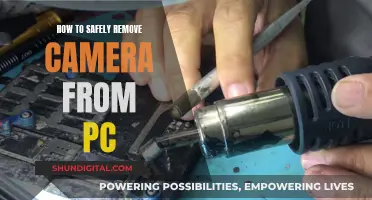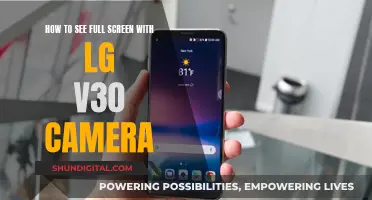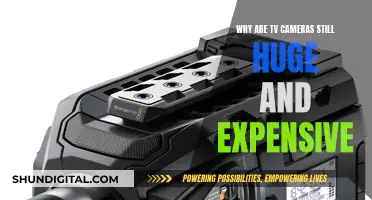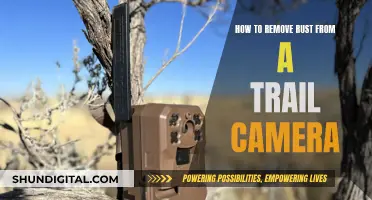
Mirrors have been a source of trouble for filmmakers since the dawn of cinema. The issue is that mirrors reflect the camera and crew, which can ruin a shot. There are several ways to avoid this. One is to angle the mirror so that the camera is out of view. Another is to use visual effects (optical or CGI) for the reflection. A third way is to build a duplicate set and use acting doubles, as in Terminator 2, where Linda Hamilton's twin sister was her mirrored body double. A fourth way is to use a fake wall and digitally remove the camera and crew, as in the film Force Majeure. Finally, a remote-controlled camera rig and digital rotoscoping can be used, as in Criminal: UK.
| Characteristics | Values |
|---|---|
| Lighting | Use bright lights to reduce the amount of light bouncing off objects and people on set. |
| Lighting | Use wash lights to shine a bright enough light to override any other reflection. |
| Lighting | Keep the set brightly lit and everything else in total darkness. |
| Camera placement | Angle the mirror so the camera is out of its view. |
| Camera placement | Use a longer focal length so the camera can be farther away. |
| Camera placement | Use a tilt-shift lens to correct the perspective in post-production. |
| Camera movement | Use a duplicate set and acting doubles to allow the camera to move without being reflected. |
| Post-production | Use blue screen, image replacement, and stitching to combine two different shots. |
| Post-production | Use digital rotoscoping to remove the camera and crew. |
What You'll Learn

Angling the mirror so the camera is out of view
Angling the mirror so that the camera is out of view is a clever way to keep the camera out of the shot. This technique requires thoughtful camera placement and movement, as well as careful editing to create seamless transitions.
One example of this technique is seen in the film *Contact*, where the camera seamlessly transitions as the character runs towards the bathroom mirror. This shot is achieved by stitching together two different shots. The first shot tracks the character as she runs, while the second shot captures her opening the cabinet door in the bathroom. By superimposing the first shot onto a blue screen where the mirror should be, the camera can be angled out of view without disrupting the continuity of the scene.
Another example of creative camera angling can be found in Zack Snyder's *Sucker Punch*. In this film, the camera starts on one side of the mirror and transitions to the other side without the use of VFX. This effect is achieved through the use of a duplicated set and cast, creating a mirror image of the scene. Small details, such as pictures tucked into the mirror and makeup scattered across the vanity, help sell the illusion of a reflection.
In addition to clever angling, lighting also plays a crucial role in keeping the camera out of view. By keeping the set brightly lit while maintaining darkness elsewhere, reflections off surfaces can be minimised. This technique, combined with the use of wash lights, helps to ensure that only the intended reflections are visible in the final shot.
Camera placement and movement, editing, and lighting techniques all contribute to the successful execution of keeping the camera out of view in mirror shots. These methods require careful planning and execution but can result in iconic and visually stunning scenes that maintain the immersion of the audience in the film.
Stream Your Eufy Camera on TV: Easy Guide
You may want to see also

Using visual effects (optical or CGI) for the reflection
Using visual effects for reflections is a tricky business, and filmmakers have a few methods to avoid capturing the camera or crew in reflective surfaces. Firstly, the use of bright lighting on set and darkness off-set reduces the chance of any unwanted reflections. This is because there is less light to bounce off objects and into the reflective surface.
Wash lights are often used to achieve this, as they are powerful enough to override other reflections. The result is that any reflection of the crew or equipment is outshone by the bright light, which covers everything, so no specific source of reflection can be seen. This also explains why shadows from the crew or equipment are rarely seen.
Another technique is to use a longer focal length for close-up shots, which allows the camera to be positioned further away from the actor. This set-up reduces the chance of the camera appearing in any reflections. Additionally, wide-angle lenses are not typically used for close-ups as they can distort proportions, so a longer focal length is preferable for aesthetic reasons.
The reflectiveness of the eyes is also a factor to consider. Eyes do not tend to reflect much, and it is rare to see a clear reflection of your face when looking in a mirror. Usually, only bright lights are reflected, and these can be manipulated by the lighting technician to ensure they do not give away the position of the film crew. The focus of the camera can also be adjusted to ensure that any reflection is out of focus, with variables such as brightness, light direction, and depth of field all playing a part.
Toshiba Fire TV: Camera-Equipped or Not?
You may want to see also

Building a set with a mirror that is actually a window
Building a movie set with a mirror that is actually a window can be a great way to achieve a unique visual effect. Here's a step-by-step guide to help you create this illusion:
Step 1: Choose the Right Window
First, select a window in your filming location that you want to transform into a mirror. Consider the size, shape, and positioning of the window to ensure it aligns with your desired shot composition.
Step 2: Prepare the Window
Clean both sides of the window thoroughly to remove any dirt, dust, or smudges. This step is crucial to ensure that the reflective surface you'll be creating is clear and free of imperfections.
Step 3: Apply Reflective Coating
There are a few ways to create a reflective surface on the window:
- Two-Way Mirror Film: Apply a two-way mirror film to one side of the window. Cut the film to size, spray the window with soapy water, and carefully apply the film, smoothing out any bubbles with a squeegee. Let it dry completely before proceeding.
- Mirror-Effect Spray Paint: Alternatively, you can use mirror-effect spray paint to create a reflective surface. Remove the window pane, place it on a well-ventilated area, and apply several light coats of the spray paint, allowing each coat to dry before applying the next. Once dry, reinstall the window pane.
Step 4: Lighting and Camera Setup
To achieve the mirror effect, the lighting and camera setup are crucial:
- Lighting: Ensure that the room with the window is brightly lit, while the area outside the window is as dark as possible. This lighting contrast will help create the illusion of a mirror when filming.
- Camera Angle: Position your camera so that it captures the reflection of the brightly lit room in the "mirror." Avoid including the outdoors or any external light sources in the frame, as this will give away the illusion.
Step 5: Test and Adjust
Finally, test your setup by filming a scene with an actor standing in front of the "mirror." Review the footage to ensure that the window appears as a mirror and make any necessary adjustments to lighting or camera angle.
By following these steps, you can effectively build a movie set with a window that functions as a mirror, creating a unique visual effect for your film.
Pinhole Camera Eclipse Viewing: A Safe, Easy Guide
You may want to see also

Using a longer focal length for close-ups
When shooting close-ups, using a longer focal length can be an effective strategy to avoid capturing unwanted reflections, such as the camera or crew, in the frame. This technique is particularly useful when filming scenes with reflective surfaces like glass or metal.
By opting for a longer focal length, the camera can be positioned at a greater distance from the subject while still achieving the desired close-up shot. This increased distance helps to minimise the chances of the camera or crew appearing in reflections. Additionally, longer focal lengths tend to provide a more flattering representation of the actor's face, as they do not distort proportions in the same way that wide-angle lenses do.
The standard focal length for motion picture close-ups is typically around 85mm. This range is often preferred as it mimics the stereoscopic view of human eyes, resulting in a natural and pleasing appearance for viewers. However, it's worth noting that the specific focal length chosen may vary depending on the sensor size of the camera and the desired creative effect.
When using a longer focal length, it's important to consider the lighting setup as well. To reduce the visibility of reflections, movie sets are usually brightly lit, while the surrounding areas are kept in relative darkness. This lighting technique minimises the amount of light that can bounce off reflective surfaces and be captured by the camera.
Additionally, the use of wash lights, which are powerful lights that illuminate the set, can help to further reduce unwanted reflections. These lights are designed to override any other reflections by creating a bright, uniform light source that covers the entire set. This prevents the camera or crew from casting shadows or being visible in reflective surfaces.
Apple Watch Camera: Where is it?
You may want to see also

Using bright lights to override other reflections
To prevent the camera operator or crew from being visible in an actor's eyes during a close-up, movie sets are brightly lit while everything else is kept in total darkness. This reduces the amount of light that can bounce off objects and reflect onto the set.
Wash lights are used to shine a bright light that overrides any other reflection. Because it's just plain light and covers everything, you can't see the source of the reflection. This is also why you don't see shadows from the crew or equipment.
In addition, close-ups are usually done using a longer focal length, which means the camera can be positioned further away from the actor. Wide-angle lenses (shorter focal length) distort proportions and are not ideal for filming faces.
Furthermore, if the camera is focused on the actor's eye, the reflection will be out of focus depending on the distance of the lens from the eye and other variables such as brightness, direction, and depth of field.
Reviewing Past Activity on Your SimpliSafe Camera Footage
You may want to see also
Frequently asked questions
The camera and its operator are usually hidden by angling the mirror so that they are out of view. This is sometimes masked by the actor looking directly at their own reflection, giving the impression that they are looking at themselves in the mirror.
In these cases, filmmakers have used visual effects (optical or CGI) for the reflection, or built a duplicate set with a real mirror, and used actors' twins or body doubles.
Yes, movie sets are usually brightly lit while everything else is in as close to total darkness as possible. This reduces the amount of light that can bounce off the camera and crew and onto things on the set.
Yes, close-ups are usually done using a longer focal length, which means the camera can be farther away. Wide-angle lenses (shorter focal length) distort proportions so they are not ideal for people’s faces.







